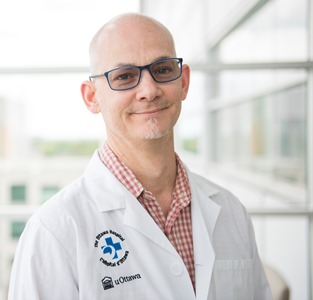 “Studying COVID-19 in a 3D tissue model provides much more data than if we were studying cells in a dish,” said Dr. William Stanford. A team of Ontario researchers is using 3D lab-grown human tissue models to understand why COVID-19 makes some patients severely ill. They also hope to identify drugs that can reduce the severity of the infection.
“Studying COVID-19 in a 3D tissue model provides much more data than if we were studying cells in a dish,” said Dr. William Stanford. A team of Ontario researchers is using 3D lab-grown human tissue models to understand why COVID-19 makes some patients severely ill. They also hope to identify drugs that can reduce the severity of the infection.
“Our hypothesis is that that patients who are very sick with COVID-19 might be infected in multiple cell types and tissues,” said Dr. William Stanford a senior scientist at The Ottawa Hospital and professor at the University of Ottawa who is leading the project. “We know the virus infects the lining of the lungs, but we don’t know where else in the body it goes. If the virus is affecting multiple organs and tissues, it might explain why an otherwise healthy 20 or 30-year-old can end up in intensive care.”
From the lining of the lungs, the virus may be able to spread to the lung’s blood vessels. It might also travel to the kidney – there have been recent reports that many patients with severe COVID-19 also experience kidney failure.
“In analyzing tissue expression data, we found that the kidneys express very high levels of the coronavirus receptor ACE-2, even higher levels than the lung cells do,” said Dr. Stanford. “This means they might also be a target for the virus.”
Dr. Stanford and his collaborators Drs. Amy Wong (SickKids) and Molly Shoichet (University of Toronto) were already making human tissue models of lungs and kidneys in their labs to study cancer and rare lung diseases. They realized these models could be repurposed to better understand how COVID-19 infects the lung and other tissues.
“Studying COVID-19 in a 3D tissue model provides much more data than if we were studying cells in a dish,” said Dr. Stanford. “We can learn how the virus normally infects human tissues, and how the immune system responds to infection. These models allow us to study the infection process in real time and ask questions that standard tools can’t answer.”
The research team will also use these tissue models to identify drugs that can make the infection less severe.
“Any medical researcher would love to help solve the biggest healthcare problem of a generation,” said Dr. Stanford. “The problem is urgent, and we need to find treatments now. If we can identify similar drugs to what other teams are finding, that will provide more evidence to start giving those drugs to patients in clinical trials.”
The team recently received funding from the Stem Cell Network to complete this research.
Collaborators: Dr. Amy Wong (SickKids), Dr. Molly Shoichet (University of Toronto), Dr. Scott Gray-Owen (University of Toronto), Stephen Juvet (Toronto General Hospital Research Institute).
Core resources: High Content Imaging Core, Human Pluripotent Stem Cell Facility
The Ottawa Hospital is a leading academic health, research and learning hospital proudly affiliated with the University of Ottawa.
Media Contact
Amelia Buchanan
Senior Communication Specialist
Ottawa Hospital Research Institute
Office: 613-798-5555 x 73687
Cell: 613-297-8315
ambuchanan@ohri.ca
